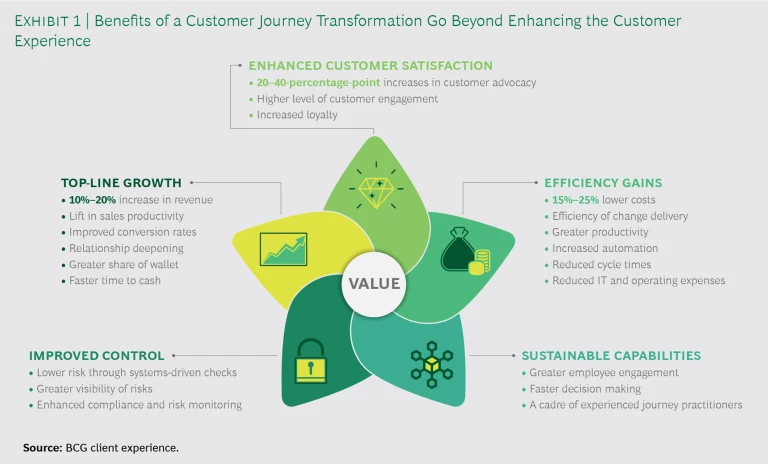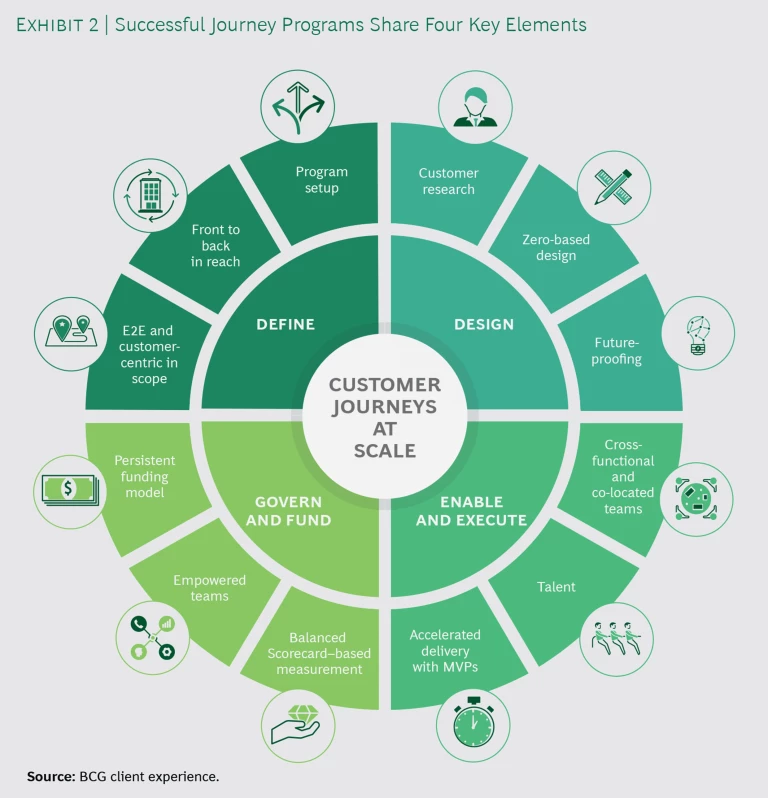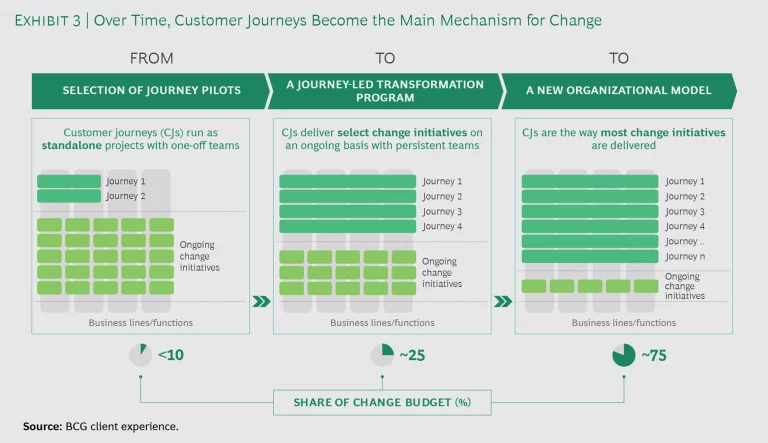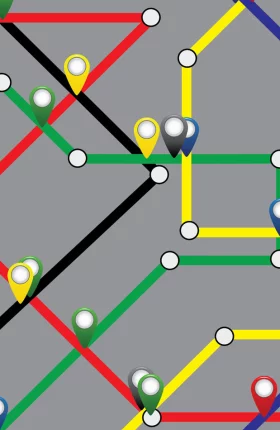Digital natives were the first to grasp an important truth—that their future growth and success depend as much on redefining the customer experience as on offering better products and services. In the digital era, the ability to pivot nimbly to accommodate changing customer tastes is critical to maintaining market share, as leaders such as Apple, Amazon, Google, Netflix, and Airbnb have so potently demonstrated. Although most companies understand the customer experience imperative, many fail to see that adding to an already long list of change initiatives is not the best way to address it. Discrete incremental improvements won’t cut it.
To put their customers at the center of their business, companies should take their cue from digital natives and reorganize change initiatives around the customer journey—an end-to-end approach to conceiving and solving each distinct customer mission. In our research and our work with more than 100 clients worldwide, we have seen the most successful clients use a customer-journey-led model for transformation that not only reinvigorates the customer experience but also meets the equally urgent objective of carrying out the company’s digital transformation. This approach, which we call customer-journey-at-scale transformation, draws on the principles of human-centric design, agile ways of working, and the latest digital and other cutting-edge capabilities, while employing best practices in change management. Underpinning it is a strong data orientation that emphasizes value measurement and enables organizations to continuously improve performance.
Why Customer-Journey-at-Scale Transformation Matters
A customer-journey-at-scale transformation reconfigures the way the company develops, delivers, and improves its products and processes in order to deliver the best possible experience to customers.
At a time when products and services are becoming increasingly commoditized, the strategic importance of customer centricity has greatly increased. Demographics are a major reason: millennials and their younger cohorts—members of Gen Z and the Founders generation—who collectively make up 50% of the US population, are socially networked and hyperconnected, and they expect instant gratification.
Millennials and their younger cohorts express the least satisfaction with their experiences with traditional companies.
Furthermore, the payoff that a company gains by adopting a customer-journey-at-scale approach can be significant. In our work, we have found that companies can realize 20- to 40-percentage-point improvements in customer advocacy, cost reductions of between 15% and 25%, and revenue increases of from 10% to 20%. (See Exhibit 1.) A study by MIT showed that companies that focus equally on transforming the customer experience and on achieving operational excellence outperform their peers by a significant amount, earning net margins that are 16 percentage points above their industry’s average.
By organizing all customer-related change initiatives around the customer journey, a company effectively transforms its operating model. Instead of running dozens of uncoordinated initiatives that span business units and functional areas (and often create costly redundancies), the company reorganizes these change initiatives around a set of end-to-end customer missions. Because everyone—not just product and delivery teams, but also back-office and risk and support teams—is brought under the same tent, companies can avoid the kinds of tradeoffs that arise with a siloed organization and can produce better, less risky solutions. The new ways of working encourage faster decision making and greater employee engagement, both of which confer long-lasting benefits.
Done properly, a customer-journey-at-scale transformation can help companies optimize their digital and automation investments, in large part by reducing duplicative investments. Customer-journey-at-scale transformation thus does more than deliver optimal customer experiences; it also gives the organization a built-in capacity for continuous improvement. Change becomes a built-in capability, integral to the way the organization operates. This capability can have dramatic effects, particularly for large companies, where transformation often seems to happen at an elephant’s pace.
Getting It Right
A successful customer-journey-at-scale transformation involves four key elements: defining the transformation, designing the journeys, enabling and executing the transformation, and governing and funding the transformation. (See Exhibit 2.)
Define the Transformation
In order to define the transformation, a company’s leaders must think holistically about the organizational requirements and implications of this integrated, customer-centric approach.
Conceive journeys from the customer’s perspective. To truly understand how best to serve customers, companies must flip their focus 180 degrees and put themselves in their customers’ shoes. Most customers don’t care how the company is organized; if anything, they should be insulated from the company’s internal complexities. Customers have a need, and they expect it to be fulfilled as seamlessly as possible, regardless of the channel they choose to use in interacting with the company.
From the customer’s perspective, most of a company’s activities look like components of a fairly small set of end-to-end journeys, rather than like hundreds of isolated processes. So, for example, instead of designing its home mortgage in terms of its discrete component steps (the application process, loan origination, the appraisal process, and so on), a bank might conceive of it as a single customer journey—namely, “helping the customer buy a home.”
Each journey—such as becoming a customer (buying a product or service), using the company’s products or services, expanding the relationship (getting additional products or services), and resolving issues—contains a set of subjourneys that in turn contain many other processes. For example, the journey “Help solve our problems and issues” might include such subjourneys as “Help me with information edits and inquiries,” “Help me with transactions I don’t recognize (fraud/dispute),” and “Help me close an account,” each of which involves a host of individual processes invisible to the customer.
Properly conceived, any customer journey involves many moving parts that the company must connect and orchestrate.
Factor in all the necessary functions and operations. Many companies make the mistake of thinking that simply improving interactions at any given customer touchpoint constitutes creating a customer journey. But introducing a mobile app or dressing up a website or streamlining sales channels won’t necessarily produce a quicker or easier path to a better customer experience. When properly conceived, any customer journey involves many moving parts that the company must connect and orchestrate, including the behind-the-scenes middle and back offices and various support functions that have no direct contact with customers, such as marketing, product, operations, HR, finance, legal, risk, and compliance. So, when a customer clicks on “help me buy a home” online, that single action should set in motion a series of interconnected activities and responses that will carry the customer seamlessly through all of the steps, from automated application to funds received. The upshot is that most of the choices that the company makes about its internal processes, policies, and procedures could occur within the scope of the overall customer-journey-at-scale program.
Treat journeys collectively as a comprehensive effort rather than as separate projects. Because the customer-journey-at-scale transformation is a long-term program, setting it up requires both thoughtfulness and boldness. As a first step, the company needs to develop a list of relevant journeys, evaluating the business benefits of each and tying the expected outcomes to the company’s overall strategy and purpose. These journeys then become the primary basis for organizing teams. The company should realign existing teams and initiatives in accordance with this new structure, and should fill any resource or skill gaps that result from adopting it. The company should also appoint high-potential talent as journey leaders, making them accountable for the overall journey outcomes.
To support the journey program, company leaders must activate a set of enablers. These should include modified incentive plans, performance management metrics, career growth plans and reporting structures for team members, training for senior leaders in the new ways of thinking and working, and suitable new workspaces for the colocated teams. It’s also important to establish a journey delivery center to serve as the heart of the transformation program. The delivery center will handle financial management, reporting, value tracking, and resourcing key talent, as well as managing partnerships and coordinating with other areas of the organization (such as procurement, finance, and human resources). The delivery center is also responsible for creating and maintaining the customer journey methodology and standards, in addition to providing learning and development to journey team members.
Design the Journeys
Some companies give customers what they think the customers want—based mostly on cursory evidence or gut instinct—but often they guess wrong. Designing customer journeys takes extensive, ongoing study and an innovation mindset.
Use human-centered design to gain a deep understanding of your customers. Human-centered design (HCD) puts the customer’s needs first. HCD can help companies craft products and services that resonate with customers and reinforce their engagement with the company. This approach to design entails ethnographic studies, in-depth interviews, and quantitative research. It also requires an understanding of the many kinds of customers that the company might serve—their demographics, attitudes, motivations, behaviors, and unmet needs. Because customer needs and preferences are constantly changing, research is not a one-and-done operation. It’s important to invest in building capabilities for continuous testing with customers.
Use zero-based design to reimagine journeys. To reimagine customer journeys effectively, companies can’t allow their existing capabilities, systems, organizational structure, or resources to constrain them. The best way to reimagine journeys is through an approach known as zero-based design: starting from a clean slate to develop innovative solutions that truly address the customer’s needs. For example, if the goal were to devise a novel way to bank, the company might start by asking, “If a digital native were to start a bank, how would it approach the task?”
Human-centered design can help companies craft products and services that resonate with customers and reinforce their engagement.
In contrast to business process reengineering initiatives, which seek incremental improvements to current processes, customer journey designs seek fresh solutions, which could mean eliminating a process as it currently exists.
Future-proof your design. Transforming customer journeys involves adopting state-of-the-art digital technology and tools such as robotics, artificial intelligence, automation, and machine learning. Digital technologies and tools can help streamline or even replace existing processes—for example, by auto-filling applications, identifying next-best offers, or performing real-time error checking. By integrating these processes into a journey program, rather than adopting them in separate initiatives, companies can obtain a better return on investment.
Enable and Execute the Transformation
Organizing for customer journeys at scale calls for more diffuse decision making and faster action. These, in turn, require innovative approaches to configuring teams, new ways of working, and the right mix of talent and skills.
Organizing for customer journeys calls for more diffuse decision making and faster action.
Appoint dedicated cross-functional teams. Every customer journey requires contributions from talent throughout the organization, so the journey team should be composed of members from every relevant business and functional area. The cross-functional team brings together designers, analysts, process engineers, data scientists, developers, business managers, technology specialists, and other personnel.
Representation from every part of the organization ensures that the relevant skills are on hand, that all stakeholders remain up to speed on project progress and issues, and that they can work together to quickly overcome roadblocks. People from support functions such as Legal, Risk, Compliance, HR, and Finance should also contribute to design from the outset. Finally, members of each journey team should be colocated to ensure optimal coordination.
Over time, the silos disappear. People retain their functional area affiliations but move away from functionally based organizations and toward journeys. As execution commences, journeys become home base for the team, whose members now show up for work in journey rooms, rather than in physical departments. The functionally based organizations remain as horizontal constructs that focus chiefly on building skills and maintaining standards.
Invest in the right talent. Ideally, every journey team will have a good mix of talent, with skills in such areas as human-centric research, lean process engineering, UI/UX design, scrum (the agile process framework), and data science. But the right talent has more than technical know-how. Journey team members should be risk takers, iconoclasts, and high-potentials.
Often, companies discover that they do not need to hire new people in order to launch a customer-journey-at-scale transformation. Many companies that we have worked with around the world have successfully used existing resources or have trained people, both formally and on the job. Creating and launching their initial journey programs enabled these companies to develop a cadre of experienced practitioners who then went on to lead and support other journey programs.
Embrace agile principles. Agile ways of working profoundly influence product development and delivery in a wide range of industries. Agile’s core principles—aim for action over deliberation and for speed over perfection, and think big but implement gradually—are tailor-made for creating customer journeys. So are its key characteristics, most notably the basic work unit consisting of small, self-guided, multidisciplinary teams that work iteratively.
Customer journey teams should first identify small-scale, straightforward initiatives that can begin producing results in less than four weeks.
The tasks of working and thinking in agile ways call for a fundamental change in an organization’s culture and values—in particular with regard to its bias toward action. Customer journey teams should therefore identify small-scale, straightforward initiatives requiring minimal technology change that can begin producing results in less than four weeks. Meanwhile, as they pursue the target ideal—or North Star—journey, each team should strive to produce a minimum viable product every 12 to 16 weeks. Leaders should encourage a fail-fast mentality so that teams can cut their losses on initiatives that don’t work out and can shift nimbly to the next promising idea.
Govern and Fund the Transformation
The highly variable structures and cadences of customer journey work mean that companies must adapt their process of governing, their incentives system, and their approach to funding.
Promote a data-driven culture committed to value generation. Companies need to know that every journey-at-scale program is creating value—and if one is not, they need to know what to do to correct its course. A comprehensive method for governing and for tracking progress is critically important, especially given the many interdependencies that customer journeys entail. Tools such as balanced scorecards that track financial, operational, and customer metrics are well suited for continuously tracking performance.
Empower teams and align incentives. Effective journey teams are largely self-driven. Leaders set high-level objectives but let the teams make day-to-day design and implementation decisions, as long as they meet their targets and conform to the business’s strategy. This autonomy does not lead to anarchy or mayhem, as some people might expect. Leaders still make the strategic decisions and define KPIs for the teams. They also hold biweekly check-ins with teams. Together, these practices produce a higher level of transparency than we find in traditional organizations.
Owing to the radically different nature of journey teams, traditional performance metrics are not useful for assessing them. Each team member’s KPIs should mirror the journey scorecard to ensure that its goals and incentives are aligned with journey outcomes. Each team has an appointed journey owner who is responsible for adhering to goals and aligning with stakeholders on important decisions. In place of briefings, senior leaders engage with their teams in person in the journey rooms. In addition to encouraging frequent leader and team feedback, the governance model includes a built-in escalation mechanism.
Devise a persistent funding model. Customer-journey-at-scale transformation quashes the proliferation of business cases (which often total in the hundreds) that are associated with multiple change initiatives. It also avoids project-based funding that starts and stops every few months. Because they function as ongoing programs, journeys receive dedicated, multiyear funding to ensure that teams can achieve the desired results. Unlike traditional projects, however, journey programs are not funded blindly at the start of the budget cycle. Thanks to the transparency and ongoing measurement of the programs, companies have the flexibility to modify funding in response to performance.
The Secret to Success Lies in Scale
Companies realize the most profound benefit of the customer journey transformation only when they have mobilized the entire organization around journeys. Over time, as more journeys emerge and gain scale, the company’s change initiatives are ultimately organized around journeys. (See Exhibit 3.)
Reorganizing around customer journeys is a transformational endeavor. Companies can’t build journeys discretely or in isolation; they need to reconfigure the way the organization and its people work and improve and track progress. But with a new orientation and approach—and with digital strength and fluency in change—any company can coherently, consistently, and fully act on its belief that the customer is the center of its universe. By tapping the power of a customer-journey-at-scale transformation, even elephants can sprint.









